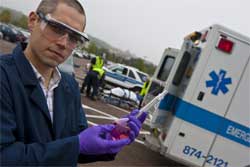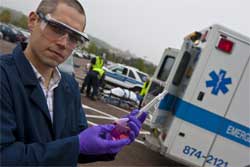 KINGSTON, R.I. – September 26, 2012 – A chemistry professor at the University of Rhode Island has been awarded a $400,000 research grant from the National Science Foundation through its Faculty Early Career Development program, the most prestigious NSF grant program supporting junior faculty members. The five-year grant will enable Assistant Professor Jason Dwyer to combine elements of chemistry and engineering to develop new methods for diagnosing medical conditions using hand-held technologies.
KINGSTON, R.I. – September 26, 2012 – A chemistry professor at the University of Rhode Island has been awarded a $400,000 research grant from the National Science Foundation through its Faculty Early Career Development program, the most prestigious NSF grant program supporting junior faculty members. The five-year grant will enable Assistant Professor Jason Dwyer to combine elements of chemistry and engineering to develop new methods for diagnosing medical conditions using hand-held technologies.
“The focus of my research is to build next-generation devices that are cheap, reliable and easy-to-use so that they can be used equally well for routine medical diagnostics in the clinic, at home, and in more challenging environments such as a roadside accident or a makeshift clinic in a disaster zone,” explained Dwyer, a resident of Providence.
According to Dwyer, the key to inventing such a device is to develop a chemical sensor that can detect low levels of molecules in the blood that are indicators of disease.
“We will follow two main design principles in this work. We want to sense individual molecules, so we’ll build molecular-scale tools — in this case, nanofabricated holes that can fit only a single molecule at a time,” said Dwyer. “And we want to let special molecular recognition agents, such as antibodies, do the work of identifying the molecules present in a sample.”
Dwyer calls this research technique “catch-and-release fishing.”
“The molecule I’m looking for is floating in the blood stream, so I’m going to dangle my molecular recognition agent – that’s the worm on my hook – and let it do the work of catching the one that I want,” he said. “After a period of time, I pull up my hook, and I can tell what I’ve caught by how hard it holds onto the molecule that I’ve caught.”
“It can lead to personalized medicine if we search for clinically relevant DNA sequences,” he said. “When the test is reliable and cheap, we can also imagine routinely monitoring a patient’s health at the molecular level.”
The next challenge will be to turn the molecular sensor into an easy-to-use, hand-held device.
“You can build a $500 million machine that can reveal details about how molecules interact with each other,” Dwyer said. “But that’s like trying to look at something as small as a molecule with a machine the size of a football stadium. We’re after really small things, so we want our tools to be small, too. And then we have to package it like an iPod so users can push buttons to get useful information.”
An important element of the National Science Foundation’s Faculty Early Career Development grants is to link research with teaching and outreach. So Dwyer will involve many of his students in the project and teach them how to share their enthusiasm for chemistry and engineering with the general public.
“New technologies need champions, and there’s nobody better to be a champion than the student researchers who developed it,” he said. “My students will not only be able to design better biomedical diagnostics, but they’ll be able to inspire the next generation of scientists and engineers.”
Dwyer will provide his students with media training, work with them to produce short feature stories for the URI radio station, and offer them opportunities to develop science activities with high school students at TIMES2 Academy in Providence.
In 2011, Dwyer discussed his research at the URI Honors Colloquium. The lecture can be viewed in its entirety at www.youtube.com/watch?v=mSw8JDlO2Xg.
Department of Communications & Marketing photo by Joe Giblin

